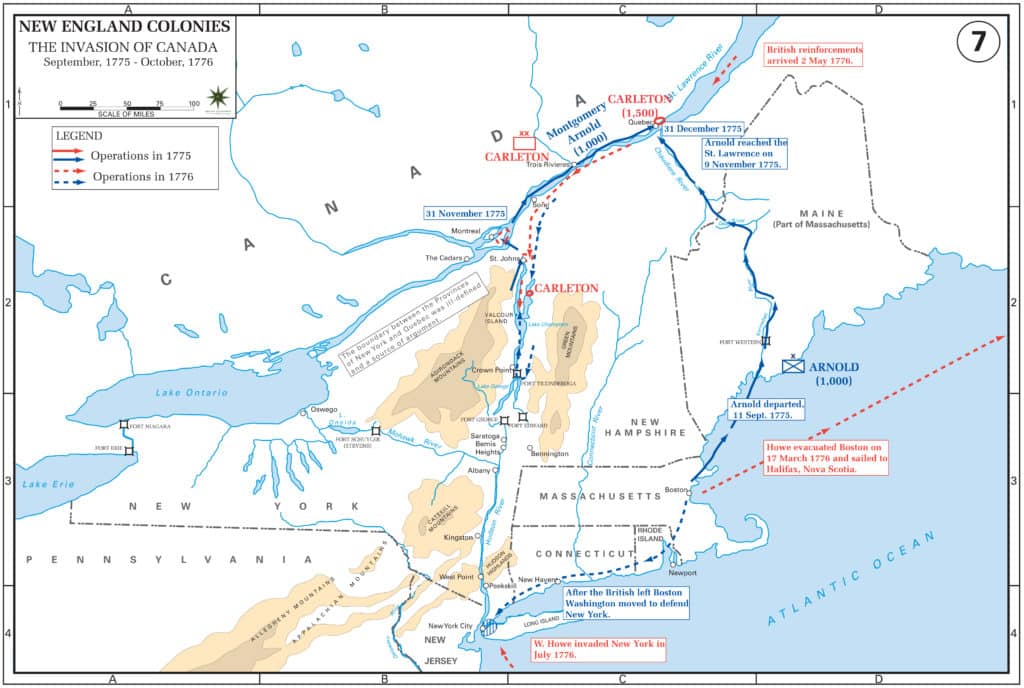Battle of Quebec Overview
Date of Battle: December 31, 1775
Region: Quebec City, Quebec Province, Canada
Opposing Forces: British: 1,800; American: 950
Jump to:
British Perspective: The British were surprised by the American successes in Canada. The capture of Montreal and the Siege of St. John caused British General Guy Carleton to prepare for surprise attacks within Canada. He guessed that the Americans would make an attempt on Quebec. He guessed right and was prepared for the assault on the capital city of Canada.
American Perspective: Americans had a series of small victories that gave them a sense of false optimism. From the capture of Fort Ticonderoga to their victories within Canada, the Americans believed that had a real opportunity to capture Quebec and drive the British out of North America. Unfortunately, the march was long, cold, and dangerous. The Americans took heavy casualties in the form of desertion and disease. When they arrived in Canada, they succeeded in defeating the British at a few strategic locations, but their goal was Quebec.
Battle of Quebec Facts: The Fighting
The Battle of Quebec was the culmination of an epic journey through the wilderness. The Americans had marched through a blinding snowstorm to arrive at Quebec. The commanding officers, Benedict Arnold and Richard Montgomery, were forced to make quick preparations for an attack due to enlistments running up.
On December 31, Richard Montgomery mustered his men to make a surprise attack on Quebec. Due to the snowstorm, their movements had went unnoticed by the British until a deserter from the American forces arrived in Quebec and alerted Carleton of the attack. The two commanders planned a pincer attack where the forces would attack Quebec simultaneously on both sides.
The American plan was ambitious, but it was met with disaster. General Montgomery led his troops near Wolfe's Cove at the southern end of Quebec and was met with an ambush. Carleton was waiting for him and unleashed a deadly barrage of infantry and artillery fire. It was during this attack that Richard Montgomery died. Lieutenant Colonel Donald Campbell took over command and ordered a retreat. The remaining men fell back, including future vice-president Aaron Burr. They would be unable to assist Arnold in his attack.
On the other side of the lower city of Quebec, Benedict Arnold successfully maneuvered his men through Quebec. He did not know of Montgomery's fate and continued to push forward. During his advance, he took on many British prisoners, and his line became scattered. On the recommendation of his fellow officers, he halted his advance to re-organize his men. This gave British commander Guy Garleton time to strategically place his men around Quebec. Arnold's advance was quickly ended, and some of the officers in command were thrown into precarious situations. Arnold ordered a retreat but ended up losing many of his men, including losing Daniel Morgan, to capture.

Battle of Quebec Facts: Online Resources
- Wikipedia - Battle of Quebec (1775)
- British Battles - Battle of Quebec
- Library of Congress Collection of Revolutionary War Maps
- West Point Battle Maps of the American Revolution
- Journal of American Revolution - March to Quebec and the Fog of War
- The History Junkie's Complete Guide to the American Revolutionary War
- The History Junkie's Guide to American Revolutionary War Battles
- The History Junkie’s Guide to the American Revolutionary War Timeline
- The History Junkie’s Guide to the 13 Original Colonies
